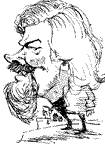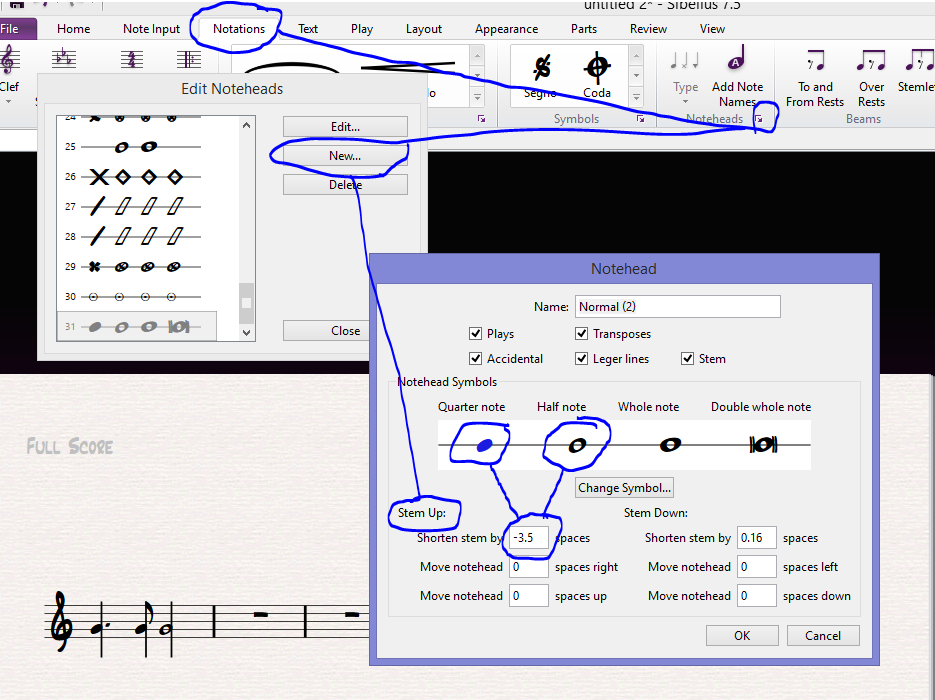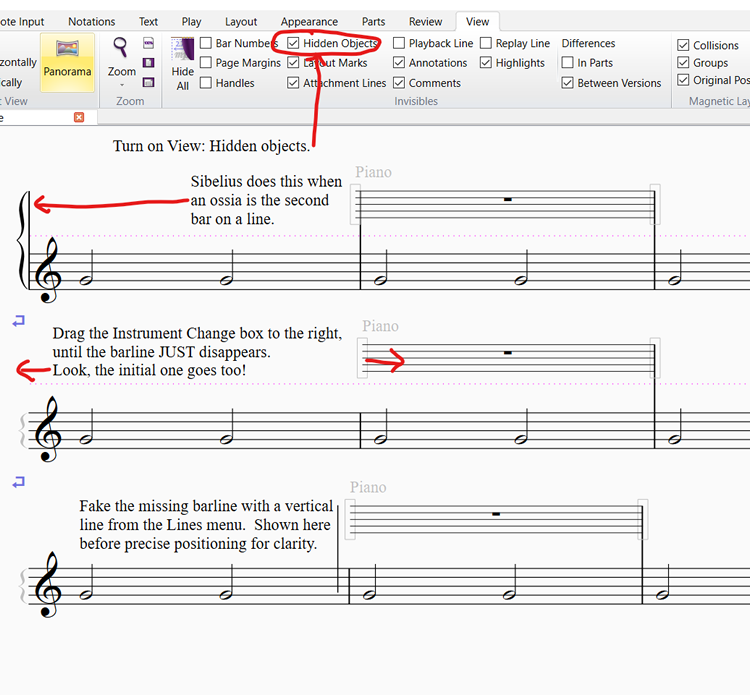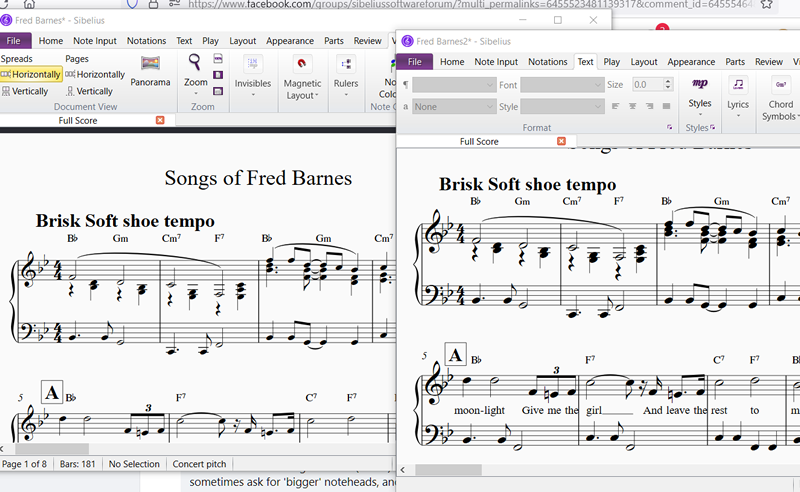Laurence Payne's Sibelius FAQ
last updated March 2024
Frequently Asked Questions, incorporating 'Things I Thought Everybody Knew!' arising from questions asked on the Sibelius forum or the Sibelius mail list. Or even the various Sibelius-related Facebook groups. Though I prefer to work in a forum where sib files can be freely attached to queries and replies.
There's a Cubase FAQ page too, though I haven't updated it for some time.
This is fun!
- 'Error Message: "There was a problem initializing the licensing engine"'
- Registration and download
- Duplicate Part
- Gap before bar
- Expand/Contract spacing
- Four bars to a line and Proportional Spacing
- Repeat Text
- Where have the bar lines gone?
- And where are the bar numbers?
- Install old version before update?
- Mac-specific issues, including missing fonts
- Keypad, Navigator, Mixer or Playback windows are stuck at the top of the screen or missing
- When Sibelius is "broken"
- Instruments not playing in a large score using Sibelius 7 Sounds
- Fun with stems and noteheads
- Hiding bar numbers in a passage
- Ossias
- Key signature positioned after a single barline.
- Windows 10 issues
- Sibelius 7.5 bugs and features including the Bass Clarinet Patch
- Copying user-defined instruments (and other things) between scores)
- Metric Modulations - how to roll your own.
- Bypassing the Ribbon Galleries
- Best-kept secrets of Sibelius
- Auto Save
- Transferring the Sounds from another computer
- Add a graphic to Score and Parts
- Problems with Avid Link
- Flexitime and Latency
- 'Bigger' notes
- Your upgrade options if stuck on an old version (as of September 2021)
- Keyboard Shortcuts in alphabetical order
- Transposable lyric sheets
0. 'Error Message: "There was a problem initializing the licensing engine"'
Unfortunately, for Sibelius 8 users, this now has to go at the top of the list.
Here's what to do. A rather more complete list than is offered in the Avid knowlegebase. They left out the 'binding.dat' bit.
........................................................................................................
'Error Message: "There was a problem initializing the licensing engine"'
WINDOWS:
- Close Sibelius.
- Click Start.
- Type %programdata% then press Enter.
- Go to Avid\Licenses.
- Delete entire "Licenses" folder
- Then go back one folder and go to Avid\Common
- Delete "binding.dat" file
- Empty the trash.
- Reactivate Sibelius.
MAC:
- Close Sibelius.
- Open up the Finder app, then select the "Go" menu from the top,
- Then select "Go to Folder" (or Shift+Command+G) and type "/Library" and hit enter.
- Once you are in the “Library" folder, go to "Application Support/Avid”
- Delete "Licenses” folder
- Then go back one folder and go to "Application Support/Common"
- Delete "binding.dat" file
- Empty the trash.
- Reactivate Sibelius.
1. Registration and download issues.
You used to need a Serial Number (typically starting with SCEP, SCEE etc.) to register your copy of Sibelius. Current versions of Sibelius 7 have moved to a System ID and Activation ID method.
If you need them because you are installing a second instance of Sibelius 7, go to File/Help in your first installation where they are displayed. Note that System ID is specific to your licence, not to any particular computer. You use the same numbers on both your installations.
If you haven't got an already-installed Sibelius 7 to look at, go to http://www.sibelius.com/helpcenter/upgrades.html and start the procedure to download the latest Sibelius update. Your old Serial Number will get you started. On the next page, you'll be given your System and Activation numbers. This time, make a note of them!
There's another page more specifically aimed at Sibelius users at:
http://www.sibelius.com/documents/contact_form.html
When you type in a question, it attempts to show you a relevant Knowledge Base article. Sibelius have stated that they would prefer you took this route for " all non-technical support queries i.e. helping people buy/upgrade/register/activate Sibelius."
Registration support for all Avid products is at:
http://avid.force.com/Support/RegistrationCaseCreation
It's free, no ASC required, and they can sort it out.
They also seem sympathetic to users who have upgraded from Sibelius 6 to Sibelius 7 but want to install both versions on a new computer - maybe for access to the Sibelius 6 Sounds, both as an alternative set of samples and as a much less demanding device than Sibelius 7 Sounds. But you must have BEEN a Sibelius 6 owner, if you bought in at Sibelius 7, the answer's no!
If you bought Sibelius 7 online, you can download the installation files again from your account at:
http://account.avid.com
Or you should be able to. Things seem to be changing... (8 Feb 2014) Watch this space!
2. Make a duplicate Part in another transposition.
Someone wanted to print a Bb Treble Clef Euphonium Part as well as a concert pitch Bass Clef Euphonium one.
Update. This is good for Sibelius 6. But Erik Hagner reminds us that this procedure is automated in Sibelius 7. Just open a Part then use "Parts/Copy and change instrument"
Go to Parts/ New Part.
On the left is the list of instruments in your score. Click Euphonium across to the right hand column.
Look in the Parts list. You now have two identical Euphonium parts.
Open one of them. Click an Instrument Change to "Euphonium, Treble Clef" (from Home/ Instruments/ Change) into the space just before the first stave.
3. Gap before bar - global removal
Sometimes an imported file has those annoying Gaps Before Bar at the end of each line. When the music reflows (first thing to do to an imported file is generally Select All then Unlock Format) you get a split stave and extra clef in the middle of a line.

Or a mess like this, if it's a negative gap.

You can go through the score selecting the bar after each unwanted gap and, in the Inspector, set its Gap Before Bar to zero. Even better, there's a downloadable plugin (by Bob Zawalich) 'Gap before bar' that will remove them wholesale.
Or, for a quick trick, Select All, then R (for Repeat). The appended copy of your score won't have the gaps. Delete the unwanted first half, and you're done.
Update: The latest version of 'Gap before bar'
also deals with Gap AFTER bar. Sometimes the right-hand end of a stave gets stuck off-screen. We can now pull it back without having to temporarily increase the page width in order to be able to grab it. Nice one!
The Gaps can also be caused by you having tried to adjust margins by dragging the ends of staves around. All very well until the music re-flows for some reason and what was an end-of-stave is now middle-of-stave. So don't do that then!
Gaps Before Bar have their uses, but try not to introduce them by mistake.
4. Expand or contract spacing
A selected passage (or whole score selected with Ctrl-A) can have its spacing expanded or contracted by pressing Shift-Alt-RightArrow or Shift-Alt-LeftArrow. If you're doing this to get fewer or more bars on a line, don't forget to Unlock Format (Shift-Ctrl-U) first.
5. 4 bars to a line and Proportional Spacing
4 bars to a line. Frequently asked for. Not always a good idea. But easy to achieve - it's the first option in Layout/Auto Breaks. It's the default setting for Parts in some of the supplied Manuscript Paper templates. A questionable decision.
4 bars to a line with the bars aligned is a bit harder. Bob Zawalich's plugin "Proportional Spacing" sets Appearance/House Style/Note Spacing Rule to appropriate figures. Here is an example of some slightly more aggressive settings. If your notation includes accidentals, key signatures etc. you may have to reduce the staff size quite a bit (and/or reconsider how many bars to a line are practical) before Sibelius stops insisting on allocating extra space for these items.
And there's always the trick of adding a hidden voice and filling it with semiquavers. But don't try to do it by dragging the barlines around. That never ends well.
UPDATE Summer 2023 The hidden voice trick is now complicated by the new default of NOT taking hidden voices into account when spacing. There's a new function 'Reset all note spacing' (Shift-Ctrl-Alt-N) that restores the old spacing behaviour for a selected passage.
If uniform layout is of paramount importance and if playback doesn't matter you could add additional instruments until one system fills the whole page. Bar lines will then be perfectly aligned. You'll probably want to remove the initial barline.
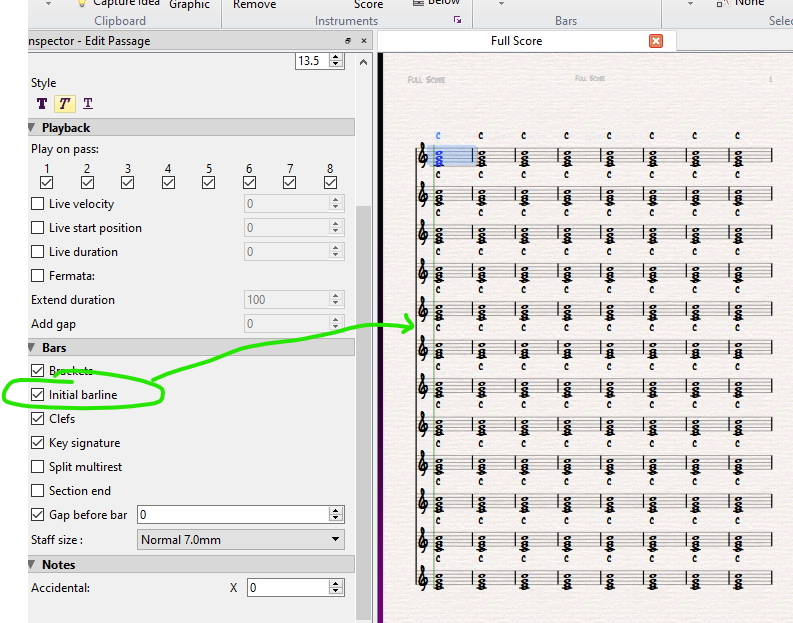
6. Repeat Text
There is often confusion over how to create functioning D.C, D.S, Coda etc. notation, and which Text Styles to use.
Tempo Text and Repeats text are both System Text styles, and both work for DC, DS, al Coda, Coda and Fine. The difference is: Tempo Text left-aligns to its attachment point, Repeats Text right-aligns. Attach “Allegro” to the beginning of a score and switch it between Tempo Text and Repeats Text – you’ll see what I mean.
As alignment is a property of the Text Style, this explains why Sibelius requires you to choose “Coda” from a different menu to the rest.
Tempo Text is therefore suitable for “Coda”- it needs to appear after the jump point. Repeats Text is better for “To Coda”, “D.S.” etc. - which normally appear before the jump point. But you could use the same Style for each, taking care to position the text WITHOUT changing its attachment point by Alt-dragging.
The S sign can be a Zymbol (set as System) or a text character from any System Text Style. The Zymbol can only be small or very small. The character is fully resizable. Seems a bit of a no-brainer to use the text character then! Whichever you choose, be aware of its attachment point, and of the Alt-drag technique for positioning it without messing up the attachment point.
The Coda symbol is, by default, purely cosmetic. The convention where just the sign is used for both “To Coda” and “Coda” could be achieved by including but hiding functional text. It would be difficult to define the Coda sign as meaning both!
7. Missing bar lines
All the bar lines have disappeared! It's quite easy to inadvertently multi-select every bar line throughout an instrument's part by clicking on the "handle" at the intersection of any bar line and the top or bottom line of a stave - then press Delete! If you catch it straight away, press Ctrl-Z of course. Otherwise, you can get them back by borrowing from the instrument below or above. Turn on View: Handles (not essential, but it helps you see where the handles ARE). Drag the handle at the bottom of a barline down (or up) across the stave without any.
If there isn't another instrument, or we're in a Part, add one. Any instrument will do. (Thanks Terry Dwyer for reminding us a short ossia will do nicely, and only takes one click.) Once you've borrowed its bar lines, delete it.
If we're in a Part, there's not even any need to drag the barline down. Select a bar, Create Ossia, Ctrl/Cmd/Z. Three clicks!
More information here:
http://www.sibelius.com/helpcenter/article.php?id=424&languageid=1&searchid=1238284
http://www.rpmseattle.com/of_note/how-to-restore-missing-barlines-in-one-staff-of-a-score-in-sibelius/
8. ...and Missing bar numbers
This happens when the repeat structure of your score is broken. If playback won't get to a section of the score, because you've confused Sibelius with illogical notation, bar numbers stop being shown.
The most common reason is using the wrong sort of Line for 1st time, 2nd time etc. brackets. The last one - the one that "carries on" - needs an open-ended line. The ones that "go back" need a hooked-end one. The next most common reason is a Start Repeat barline that doesn't have a matching End Repeat one.
If playback doesn't matter, you can cop out by going to Play/Repeats and clicking "Don't play repeats". Bar numbers will reappear. There's also an option there to set up a manual playback map, which can occasionally be necessary for complex repeat structures. (But make sure a human player would understand the notation. Generally, if Sibelius finds it confusing, so would a live musician.)
9. Do I have to install an older version before an update?
You've got a new computer, or you're re-installing after a crash. You originally bought (say) Sibelius 5, and have bought the updates to Sibelius 6 and Sibelius 7. Do you need to install 5, update to 6, then update to 7?
No. You need to obtain the latest version of Sibelius 7 and install it straight away. Incremental updates (5.0 to 5.1 etc.) may be patches - a small downloaded program modifies the existing program code. But full-version updates (5 to 6, 6 to 7) are the full program. You get discount pricing for being an existing owner. That's the only difference between a new purchase and an upgrade one.
10. Mac-specific issues
Noteheads missing, or displaying strangely? Try THIS advice from Sibelius.
Another possibility: Malfunctioning Sibelius 7 Sounds and crashing when saving a sib file may be caused by a Mac program called Audio Hijack Pro. This solution has been offered - thanks to whoever originally posted it.
1) In Audio Hijack Pro, go to the menu item Audio Hijack Pro:Install Extras...
2) In the Instant On portion of the window that will open, click on the Settings button (lower right hand corner) and choose Uninstall.
3) Restart the computer.
Update: The real solution seems to be to update the program.
http://www.sibeliusblog.com/news/rogue-amoeba-release-audio-hijack-pro-and-airfoil-updates-to-fix-sibelius-conflict/
11. Keypad, Navigator, Mixer or Playback windows are stuck at the top of the screen or missing
Here's the official set of solutions for all Sibelius versions up to 7.
http://avid.force.com/pkb/articles/en_US/troubleshooting/en361889
On Windows, there's a quick fix if you can see ANY part of the window.
Click on the part of it you CAN see. Press Alt-Space to open its position control window. Press M to select Move. Use the Arrow keys to move it back on screen.
12. When Sibelius is "broken"
Sometimes things go wrong. Sibelius runs very slowly, or won't run at all. You can un-install and re-install all you like, or delete the visible User Preferences, but nothing helps. But if you create a new User Account, everything works again.
Robin Walker has posted invaluable instructions in the Sibelius Help Centre on how to clear out the hidden settings that are causing the problem.
Here's a link to the thread for PC:
http://www.sibelius.com/cgi-bin/helpcenter/chat/chat.pl?com=thread&start=658457&groupid=3&
And for Mac:
http://www.sibelius.com/cgi-bin/helpcenter/chat/chat.pl?com=thread&start=658598&groupid=3&
Robin has also recently offered this, for Windows users:
"Please do the following to reset the state of Sibelius:
- ensure Sibelius is fully quit and not even running in the background: if unsure, restart Windows;
- click Start -> Avid -> "Sibelius User Data";
- from inside the folder that opens, delete the sub-folders "PlogueEngine" and "Playback Configurations";
- right-click Start -> "Windows PowerShell"; at the resulting command prompt, type precisely:
reg delete HKCU\Software\Avid\Sibelius
then press the Enter key. This will delete all Sibelius user preferences.
The next time you launch Sibelius, Sibelius will re-create the two folders that you deleted, and all its Preferences, reset to defaults as if it had just been newly installed."
13. Instruments not playing in a large score using Sibelius 7 Sounds
There have been a few queries of this type recently.
We check that Sounds are fully installed, recommend the Bass Clarinet patch... all good and useful advice.
But very often the simple fact is that Sibelius 7 Sounds offers a lot of instruments with a lot of articulations for each - even alternative samples for multiple instances of the same instrument - and the Sibelius playback engine has a finite number of "slots" (however much RAM and however powerful your computer).
The engine is not clever enough to realise "It's more important to cut down on violin articulations and HAVE a double bass". So we must make the decision ourselves by choosing a Lite soundset. Fewer articulations are available. A staccato note will be played as a normal one only shorter, rather than as a separate sample. Bummer. But we'll GET a double bass!
14. Fun with stems and noteheads.
Want this?
And for this:
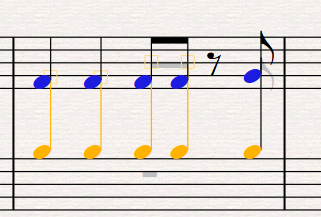
No need for a custom notehead. Cross-stave the Voice 2 notes, Drag the tip of their stems up. Hide any beams/flags.
(It LOOKS like you're selecting stem AND beam/flag for hiding, but only the beam/flag actually disappears.)
And for this:

Want rhythm hits above the stave?
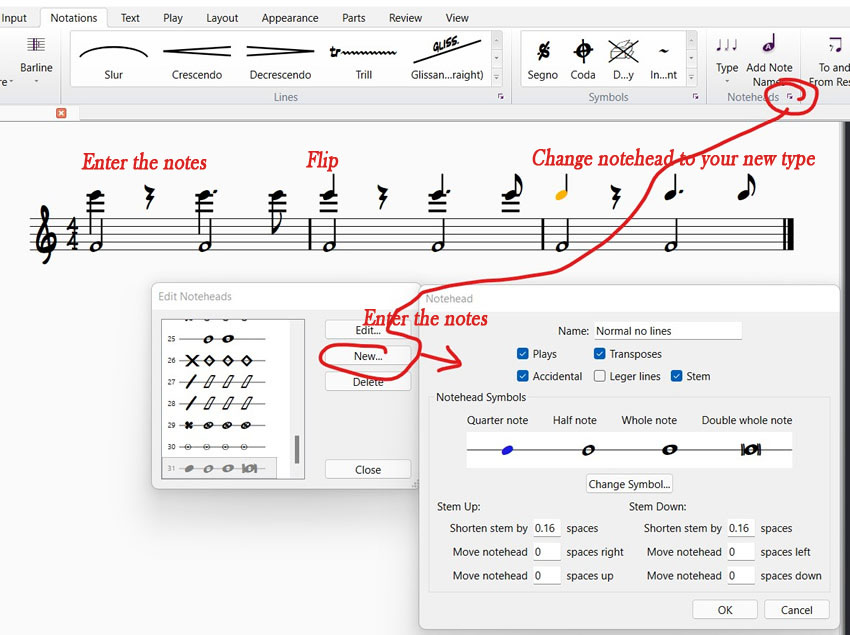
15. Hiding bar numbers in a passage.
Here's a neat way, using a Bar Number Change. Remember what a tilde character does to following text? We normally use it to hide things like mm markings. But it works on bar numbers too.
16. Ossia staves.
Ossia staves (rather like Extracted Parts) are only occasionally the right solution.
Be aware of what an ossia stave actually is. It's an "Extra staff above" (or below) set to small size and assigned the instrument "No instrument (hidden)". It exists throughout the whole score, but is only revealed by a temporary Instrument Change to the actual instrument. Every time you create an ossia, the score gets a new empty stave. The downloadable "Consolidate Ossias" plugin can tidy this up.
If you MUST have an extra stave that cuts in and out mid-line, an ossia can be useful. Otherwise adding a stave in the usual way and using "Hide Empty Staves" is generally better.
Here's a problem with ossias creating an unwanted initial barline/brace, and a bodge for it.
Also consider a simple blanking graphic, particularly when the initial barline is not encumbered with a brace. Or maybe just juggle your line breaks so that the ossia DOESN'T start at the second bar of a system.
17. Key signatures and barlines.
HERE is the full article on Music Engraving Tips. It mainly addresses the issue 'getting the key signature associated with an instrument change to display correctly in the score and part, and not break a mulitrest in the process.'
18. Windows 10 issues
There have been some reports of Sibelius showing "No audio devices" after a Windows 10 update.
A Windows computer may have "Realtek High Definition Audio". The driver as supplied in Windows 10 can be problematic. See http://www.sibelius.com/cgi-bin/helpcenter/chat/chat.pl?com=thread&start=684731&groupid=3&
That's the right solution. But I'll leave this earlier suggestion up for the sale of completeness.
This may help. A file, portaudio_x64.dll (64 bit version) or portaudio_x86.dll (32 bit version) in the Sibelius program folder can be replaced.
Maybe connected with having ASIO4ALL installed. Tests with and without it (and to see if a laptop's onboard audio
performs acceptably in Sibelius without ASIO4ALL under Windows 10) are pending. But the portaudio_x64.dl swap was a quick fix.
http://avid.force.com/pkb/articles/en_US/Troubleshooting/en417515
19. Sibelius 7.5 bugs and features
"Swing" can now be applied, in Technique Text, to individual staves. But the global Swing setting, in Tempo Text may be broken. Reset it by going to the Playback dictionary, change Swing's effect from 'Rhythmic feel', to another option, then change it back.
Reported as fixed in Sibelius 7.5.1
The comma symbol can have a playback effect in Sibelius 7.5. Nice - but there's a bug. Put a comma in your score, brass sounds may start playing staccato. Select the comma, look in the Inspector and you'll find a new option called "Breath mark". Apply this.
Also fixed in 7.5.1
************************************************
There's a fault with the supplied Bass Clarinet instrument. It can prevent some instruments from playing in your score. Do THIS. Even if there isn't a Bass Clarinet in your score, still do it.
You'll need this patch even after applying the 7.5 Sounds update, it isn't included.
Update. January 2017. Sibelius 8 owners will now find Sibelius 7.5.1 Sounds, both a full version (the BIG upload) and a small updater in their Avid Account. Those who have stuck with Sibelius 7.5 will apparently still have to grab the BCP.
If your formatting has become infested with Gaps Before Bar, maybe by misguided dragging around of staves, there's now a plugin to download, 'Gap Before Bar', which can detect and remove them. Thanks to Bob Zawalich, who was enabled by the fact that in Sibelius 7.5 these gaps are now accessible to the plugin language.
20. Copying user-defined instruments (and other things) between scores)
You've created a new Instrument -"Siberian Nose Flute in G" - in one score. In another score you've defined "Chromatic Icicles". In your new work - "Arctic Winter" - you'd obviously like to use both of them. But Saving and Importing a House Style from each doesn't work - the imported Instruments don't BOTH get added. A second imported House Style knocks out the changes made by the first. And House Styles are a blunt instrument, you are often forced to copy settings that you don't WANT to copy as well as the ones you do.
So open two scores in adjacent windows.
The score including "Siberian Nose Flute in G" and the one you want to copy it to. Insert a mid-stave Instrument Change to "Siberian Nose Flute in G" in the first score. See the grey upright rectangle that denotes the Instrument Change? (Maybe you'll need to switch on View:Hidden objects.) That can be Copy/Pasted into the second score! It's now safely in the new score's Instruments list, and will stay there even after you delete the copied Instrument Change marker. Now open another score, containing another user-defined Instrument (or two, or three...) and do the same.
The same trick works for user-defined Lines, Symbols etc.
Here are some things you might want to copy across to your scores, courtesy of Bob Zawalich.
https://bobzawalich.com/wp-content/uploads/2021/10/Data-scores-for-Sibelius-21-October-2021.pdf
And some custom trill lines are offered in this article.
https://www.rpmseattle.com/of_note/half-whole-tone-flat-natural-sharp-trill-lines-in-sibelius/
21. Metric Modulations - how to roll your own
Ben Elliott offers us this key for how to construct Metric Modulations using the Opus Metronome Std Text Style. It's the first time I've seen it documented. Nice one, Ben!

Here's a demonstration Sibelius file Metro Mod Translation version 6.sib
P.S. Please think twice before
using this to indicate "Swing". Swing is not triplets. Musicians (and Sibelius playback) understand the text instruction "Swing" perfectly well. You are not Elliott Carter and you are not indicating a complex tempo relationship. The correct notation for swing is 'Swing'.
Also: I find on my Windows systems that too much editing of an existing text string is a reliable method of crashing Sibelius. Your mileage may vary. But if you're going to do trial-and-error editing of a Metric Modulation, Save first!
If you want anything beyond triplets, tough luck.
But here's METRICO
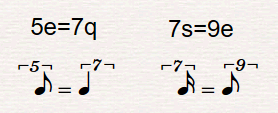
https://github.com/fkretlow/metrico
A freely-available font from @floriankretlow.
Click CODE
on the github page and Download ZIP to get everything youi need.
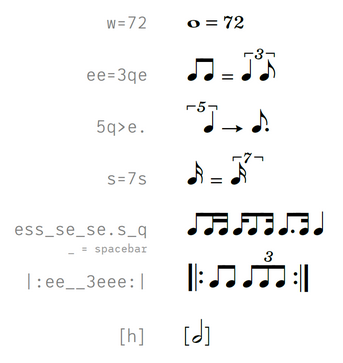
And now there's Ambitus. Like the two above, plus staff lines. Promoted as a tool for making incipits. But useful for much more, including putting snippits of notation on a Title Page.
https://www.notationcentral.com/product/ambitus/

22. Bypassing the Ribbon galleries
The new Galleries omit several useful functions. Like, for instance, creating a System version of a Symbol, or choosing the "Allow Cautionary" option for a Time Signature. And (sorry, Daniel) it's just so much easier to find something in the old Symbols menu than in that great, bloated multi-screen Gallery. (To be fair, the 'Recently used' feature is nifty though.)
They're still available however, by clicking the More Options button at the bottom of a Gallery. And if you'd like Z (for Symbols), L (for Lines), Q (for Clefs), K (for Key Signatures) and T (for Time Signatures) to lead directly to the old, compact but full-featured menus, just re-define those Shortcut Keys. The magic words are "Show.... dialog".
The quick route to a Text Style (and lots of other stuff) is still via a Right-click
on any empty part of the score page. See #23
23. Best-kept secrets of Sibelius
Shift-Alt-Left or RightArrow. This key combination stretches or compresses the horizontal spacing of a selection. Do Shift-Ctrl-N first to Reset Note Spacing. Then, if a bar is a little cramped, and you're tempted to start dragging notes or barlines around, select the passage and expand it with Shift-Alt-RightArrow. This won't help if the real problem is a forced layout with too many bars on a line though! If you MUST have all those bars on one line, perhaps the answer is a smaller staff size.
Shift-Alt-Left or RightArrow. This combination does something else as well. If you select the dot of a dotted note, it lets you move it horizontally. Maybe to underneath an adjacent black note? This can be useful...
The Bass Clarinet Patch. Never really announced, never offered as an update. But if some instruments in your score inexplicably refuse to play when using Sibelius 7 Sounds, it's the first thing to try. Even if your score doesn't incluse a Bass Clarinet. HERE it is. Read the instructions.
The R-click menus. We can still R-click on an empty part of the Score page to bring up the old menus for - well, all sorts of things. Try it.
24. Auto Save
A much misunderstood function. Are you sure you're expecting Auto-Save to do what it actually does? There's two safety systems. The Backup Scores folder, which keeps a version (not to be confused with Versions within Sibelius) every time you Save. And the Auto-Save folder, which MAY have saved your score when Sibelius crashes. A copy is saved at the user-defined interval. It is deleted when Sibelius exits normally. The idea is that it survives a crash.
Autosave has a reputation for unreliability. But it may not be as unreliable as we think. The Autosave folder may not be where you think it is, and this can be confused by old Autosave folders left behind by previous Sibelius versions.
Current Sibelius, on current Windows, keeps Autosave in C:\Users\{your_username}\AppData\Roaming\Avid\Sibelius\AutoSave. Which might be a hidden location, but is accessible by clicking Avid/Sibelius User Data in the "All Apps" list. Look there before you panic. But, if on re-starting Sibelius you aren't automatically offered an AutoSaved score, I'm afraid there almost certainly isn't one.
The main message is that is YOUR job to press Ctrl-S at frequent intervals when working on a score. You're driving this program. Take responsibility.
25. Transferring the Sounds from another computer
Downloading and installing the Sibelius 7 Sounds (also used by Sibelius 8) is a long job. If you have them already installed on another PC, Joe@Sibelius tells us:
"You can transfer the files. You'll also need to transfer a registry key that tells Sibelius where to find the library
The registry key is at this path
HKEY_LOCAL_MACHINE\SOFTWARE\Avid\Sibelius Sounds\Sibelius 7 Sounds\ContentPath
Export that key to a file, which you can then transfer to and import into the registry on your new machine.
You don't even need to update the content of the registry key itself - if Sibelius doesn't find the library when it starts, it will automatically prompt you to manually locate it."
26. Add a graphic to Score and Parts
Just to page 1. But it automatically copies to all Parts. . It won't suit every occasion. But it's worth trying. From NYC Music Services.
https://www.youtube.com/watch?v=-QtRQaN80Bs
27. Problems with Avid Link
Oh, don't get me started! But here's a dodge that sorted out a problem for me recently. From the Tech. Support forum
https://www.sibelius.com/cgi-bin/helpcenter/chat/chat.pl?com=thread&start=738364&groupid=3&
"One of my PC computers has been refusing to let me log in through Avid Link, though I could do so on the Avid Account web page.
I had tried R-clicking the system tray icon then Preferences/Clear cache files, though nothing seemed to happen. So I thought I'd try quitting Avid Link and re-starting it As Administrator. That seems to have worked."
28. Flexitime and Latency
Flexitime Input. A big selling point when Sibelius first appeared. Play from a MIDI keyboard in free tempo, Sibelius will detect the beats and deliver useful notation. Well, the 'Flexi' part never really worked. But if you set flexibility to 'none', choose sensible quantisation settings and play 'dead on the click' rather than expecting it to follow you it can be a useful input method.
But - latency. You choose a stave assigned to a Virtual Instrument (like Sibelius 7 Sounds) and play a note on your MIDI keyboard. Half-a-second later the sound arrives. This isn't caused - as you might imagine - by the MIDI connection - that's pretty well instantaneous. It's about the time Sibelius takes to process the MIDI instruction and output the sound. The 'Audio Latency' of the system. And that's about your 'sound card' and its driver.
If your 'soundcard' is the onboard audio chip of a PC computer, you've got a problem. That chip is probably very competent
at entertainment media playback, it might even support 'Home Cinema' 5.1 stereo. But, no matter how expensive and powerful the computer may be, it isn't designed for low-latency response. Realtime MIDI input will be responded to sluggishly. And score playback in Sibelius - particularly where there are more than a couple of instruments - may be rhythmically unstable and glitchy (but see note * at the bottom of this section).
Music producers who deal with multi-track recording including VST Instruments in DAW (Digital Audio Workstation) programs such as Cubase or ProTools will generally install a specialist audio interface. These days it's likely to be an external USB-connected box. The Focusrite Scarlett
2i2 is a popular choice. Install it, along with the provided VST driver - CHOOSE that driver in Sibelius (Play/Setup/Audio Engine Options) and you're good to go.
But suppose your only computer-music interest is score production with Sibelius? Playback is useful for reference, but not your main preoccupation. But you WOULD like to be able to use real-time 'Flexitime' input. Try ASIO4ALL.
http://www.asio4all.org/ It won't quite turm your onboard Realtek audio chip into a high-performance interface. But it should allow you to set latency low enough for Flexitime, and it's free!
*Note that even if your computer is incapable of faultlessly playing back a Sibelius score, the result of Export Audio will be OK. It may take longer than realtime playback to Export the file, but it won't be limited by the soundcard's performance.
Here's a good article on the subject from Daniel Spreadbury. A bit old, but the principles stand
https://www.scoringnotes.com/tips/taming-the-flexi-time-latency-beast
29 'Bigger' notes.
People sometimes ask for 'bigger' noteheads.
Bob Zawalich has written a plugin for that.
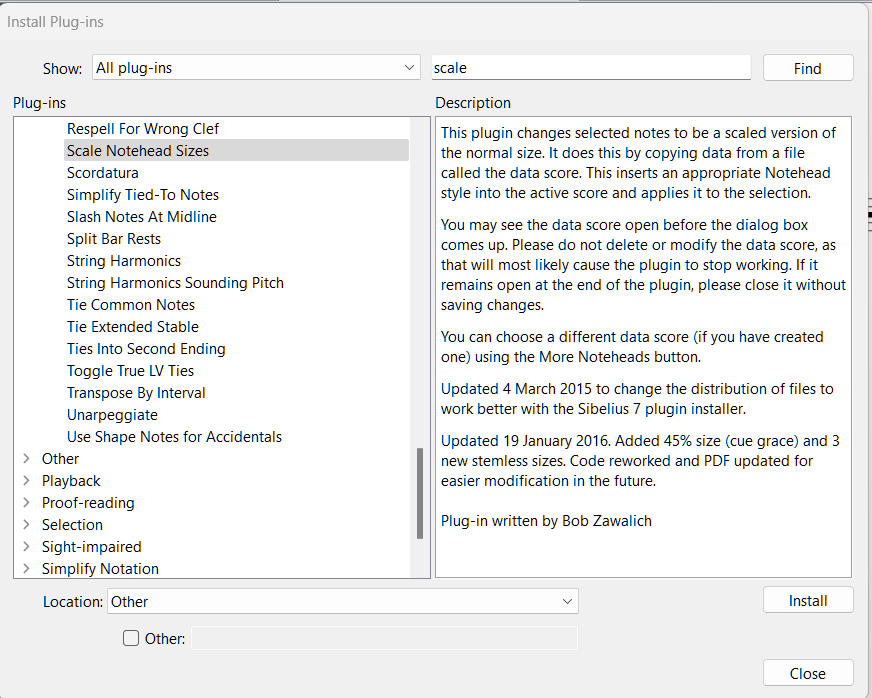
Or you can try increasing the size of the 'Common Symbols' Text Style.
30 Your upgrade options if stuck on an old version
STOP PRESS
For December 2021 only, Avid are offering the Reinstate Lapsed Perpetual deal. Hurry while it lasts!
AND THERE'S MORE!
Probably
prompted by Apple's sabotaging all but the latest versions of Sibelius with a 'pushed' os update, Avid have continued this deal (I'm writing this in September 2022). But it only seems to be available through resellers (Sweetwater etc.). You want the: "Avid Sibelius Ultimate Perpetual License Upgrade with 1-Year of Software Updates & Support Plan". This is different to 'option 3' below - it's a current deal, not scarce 'old stock'.
A must for Mac users who haven't kept up to date, and a way for lapsed PC users to get back on the bus.
.......................................................................................................................
From a reply by Robin Walker in the 'Avid Sibelius Users' Facebook group.
12 September 2020
Prices quoted below are unofficial approximate values, not quotations, for internal comparison, based on UK prices including V.A.T. Actual prices will vary according to currency, sales tax or V.A.T. in your territory, and retailer competition.
UPDATE 2023 The 'Reinstatement' deal is back until further notice.
Option 3: If you are VERY LUCKY, you might be able to find a re-seller (not Avid themselves) who still has stock of a "reinstatement" of the Support and Update Plan for Sibelius Ultimate as an upgrade from an existing Perpetual Licence for (a) Sibelius Ultimate/8.x with expired Support and Update Plan; or (b) older versions of Sibelius. But take care to ensure that you are acquiring a re-instatement, not a renewal or extension of an in-date Support and Update Plan for an existing Perpetual Licence, which will not work for you. Initial cost £200 for 1 year, or £300 for 3 years of Support and Update Plan. If still available, the edu pricing was around £80.
31 Keyboard Shortcuts in alphabetical order
The manual lists the default set of keyboard shortcuts arranged by category. Someone on Facebook requested it arranged alphabetically, so they could easily see what key combinations were used, which were available. Here's the list from the Sibelius 2021.12 manual as an .xlsx spreadsheet, sorted alphabetically.
sibelius shortcuts
32. Transposable Lyric Sheets
So: Lyrics in Plain Text. Increase the line spacing to leave space for chord symbols. Have a single stave at the bottom of the page. Create all the chord symbols you're going to need attached to it, any old way. Turn off their Magnetic Layout. Drag each one into the lyrics section. (Or Copy/Paste, leaving the original for re-use.) Hide everything in the stave, Hide Empty Staves.
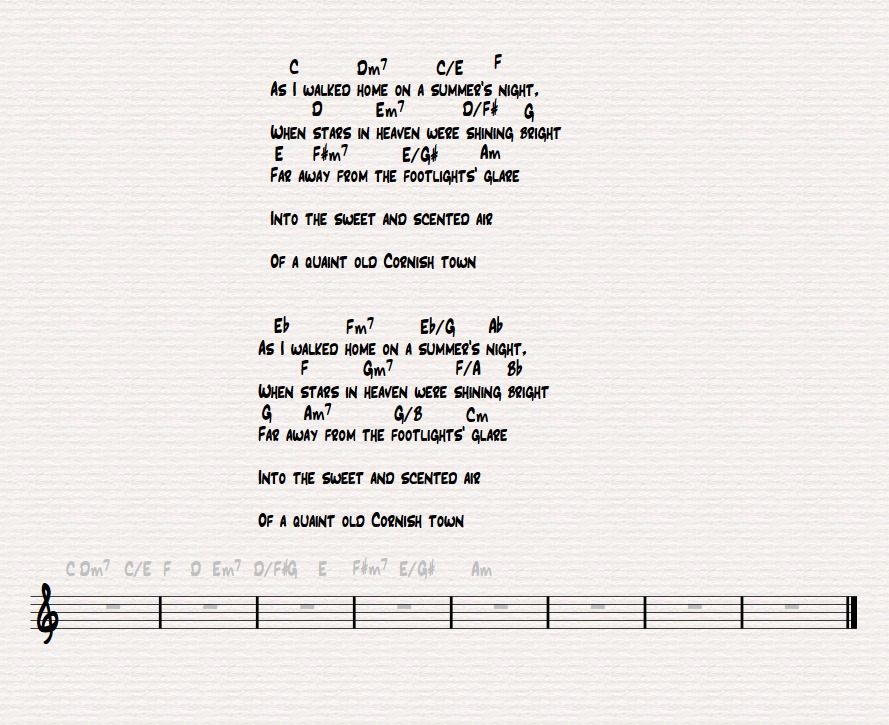
Of Note Finale & Sibelius tips and tutorials by Robert Puff
Avid's Sibelius FAQ page Informative about features, comparisom with Finale etc.
Making Notes What Daniel did next....
http://celebrant-iow.co.uk Maurice - civil celebrant for weddings, funerals etc.
www.avvalaff.co.uk
Paper Moon Theatre Company
Champagne and Smoke
Hazel Heath
The 3 Sopranos
Linda Watts
Jess Conrad - Golden Boy of the 60s
David Martin Bass-Baritone
Eastcourt Independent School
Desert Island Books specialising in Football & Dracula
The oompah band
Wallace de Pue Composer
Anne Rason Actress
Miss Helen Watson
London Concert Parties' Association
